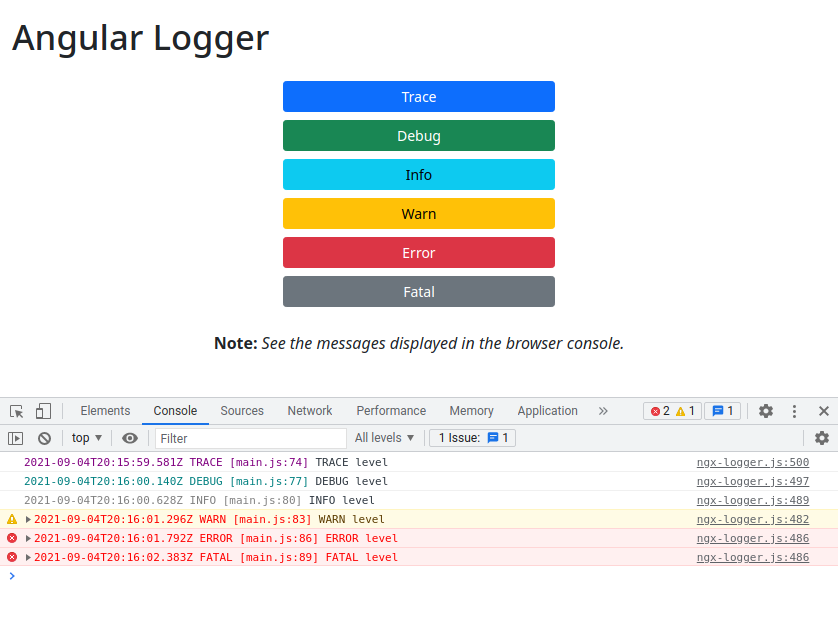Application example built with Angular 15 and adding the log component using the ngx-logger library.
This tutorial was posted on my blog in portuguese and on the DEV Community in english.
Before you start, you need to install and configure the tools:
- git
- Node.js and npm
- Angular CLI
- IDE (e.g. Visual Studio Code)
1. Let's create the application with the Angular base structure using the @angular/cli with the route file and the SCSS style format.
ng new angular-logger
? Would you like to add Angular routing? Yes
? Which stylesheet format would you like to use? SCSS [ https://sass-lang.com/documentation/syntax#scss ]
CREATE angular-logger/README.md (1059 bytes)
CREATE angular-logger/.editorconfig (274 bytes)
CREATE angular-logger/.gitignore (604 bytes)
CREATE angular-logger/angular.json (3255 bytes)
CREATE angular-logger/package.json (1076 bytes)
CREATE angular-logger/tsconfig.json (783 bytes)
CREATE angular-logger/.browserslistrc (703 bytes)
CREATE angular-logger/karma.conf.js (1431 bytes)
CREATE angular-logger/tsconfig.app.json (287 bytes)
CREATE angular-logger/tsconfig.spec.json (333 bytes)
CREATE angular-logger/src/favicon.ico (948 bytes)
CREATE angular-logger/src/index.html (299 bytes)
CREATE angular-logger/src/main.ts (372 bytes)
CREATE angular-logger/src/polyfills.ts (2820 bytes)
CREATE angular-logger/src/styles.scss (80 bytes)
CREATE angular-logger/src/test.ts (788 bytes)
CREATE angular-logger/src/assets/.gitkeep (0 bytes)
CREATE angular-logger/src/environments/environment.prod.ts (51 bytes)
CREATE angular-logger/src/environments/environment.ts (658 bytes)
CREATE angular-logger/src/app/app-routing.module.ts (245 bytes)
CREATE angular-logger/src/app/app.module.ts (393 bytes)
CREATE angular-logger/src/app/app.component.scss (0 bytes)
CREATE angular-logger/src/app/app.component.html (24617 bytes)
CREATE angular-logger/src/app/app.component.spec.ts (1097 bytes)
CREATE angular-logger/src/app/app.component.ts (219 bytes)
✔ Packages installed successfully.2. Install and configure the Bootstrap CSS framework. Do steps 2 and 3 of the post Adding the Bootstrap CSS framework to an Angular application.
3. Configure the log settings in the src/environments/environment.ts and src/environments/environment.prod.ts files as below.
logger: {
level: 'TRACE',
},4. Install the ngx-logger library.
npm install ngx-logger5. Import the HttpClientModule and LoggerModule modules. Configure the log settings. Change the app.module.ts file and add the lines as below.
import { HttpClientModule } from '@angular/common/http';
import { LoggerModule, NgxLoggerLevel } from 'ngx-logger';
import { environment } from '../environments/environment';
const environmentConfig: any = environment.logger;
imports: [
BrowserModule,
HttpClientModule,
LoggerModule.forRoot({
level: NgxLoggerLevel[environmentConfig.level],
serverLogLevel: NgxLoggerLevel[environmentConfig.serverLevel],
serverLoggingUrl: environmentConfig.serverUrl,
} as any),
AppRoutingModule,
],6. Remove the contents of the AppComponent class from the src/app/app.component.ts file. Import the NGXLogger service and create the log levels methods as below.
import { Component } from '@angular/core';
import { NGXLogger } from 'ngx-logger';
@Component({
selector: 'app-root',
templateUrl: './app.component.html',
styleUrls: ['./app.component.scss'],
})
export class AppComponent {
constructor(private logger: NGXLogger) {
}
public showTrace(): void {
this.logger.trace('TRACE level');
}
public showDebug(): void {
this.logger.debug('DEBUG level');
}
public showInfo(): void {
this.logger.info('INFO level');
}
public showWarn(): void {
this.logger.warn('WARN level');
}
public showError(): void {
this.logger.error('ERROR level');
}
public showFatal(): void {
this.logger.fatal('FATAL level');
}
}7. Remove the contents of the src/app/app.component.html file. Add the log levels buttons as below.
<div class="container-fluid py-3">
<h1>Angular Logger</h1>
<div class="d-grid gap-2 col-4 mt-4 mx-auto">
<button type="button" class="btn btn-sm btn-primary" (click)="showTrace()">Trace</button>
<button type="button" class="btn btn-sm btn-success" (click)="showDebug()">Debug</button>
<button type="button" class="btn btn-sm btn-info" (click)="showInfo()">Info</button>
<button type="button" class="btn btn-sm btn-warning" (click)="showWarn()">Warn</button>
<button type="button" class="btn btn-sm btn-danger" (click)="showError()">Error</button>
<button type="button" class="btn btn-sm btn-secondary" (click)="showFatal()">Fatal</button>
</div>
<p class="mt-4 text-center">
<span class="fw-bold me-1">Note:</span>
<span class="fst-italic">See the messages displayed in the browser console.</span>
</p>
</div>8. Run the application with the command below.
npm start
> angular-logger@1.0.0 start
> ng serve
✔ Browser application bundle generation complete.
Initial Chunk Files | Names | Size
vendor.js | vendor | 2.55 MB
styles.css | styles | 266.58 kB
polyfills.js | polyfills | 128.51 kB
scripts.js | scripts | 76.67 kB
main.js | main | 14.41 kB
runtime.js | runtime | 6.63 kB
| Initial Total | 3.03 MB
Build at: 2021-09-04T19:25:20.982Z - Hash: dcc562d0e20cf029eab3 - Time: 12067ms
** Angular Live Development Server is listening on localhost:4200, open your browser on http://localhost:4200/ **
✔ Compiled successfully.9. Ready! Access the URL http://localhost:4200/ and check if the application is working. See the application working on GitHub Pages and Stackblitz.
1. Clone the repository.
git clone git@github.com:rodrigokamada/angular-logger.git2. Install the dependencies.
npm ci3. Run the application.
npm start
